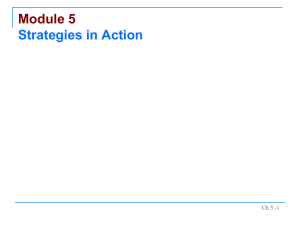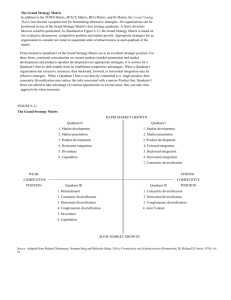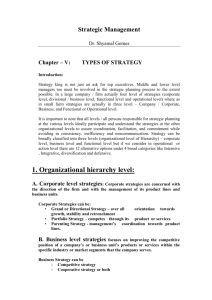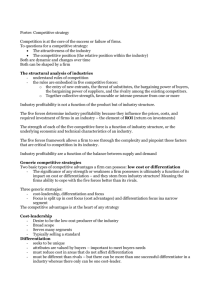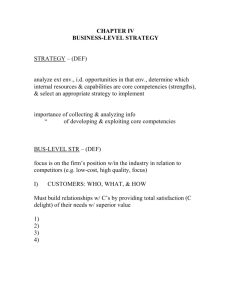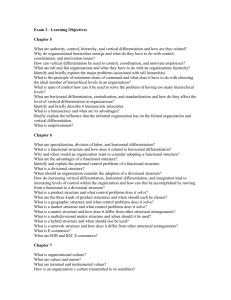OUTLINE OF REPORT
advertisement
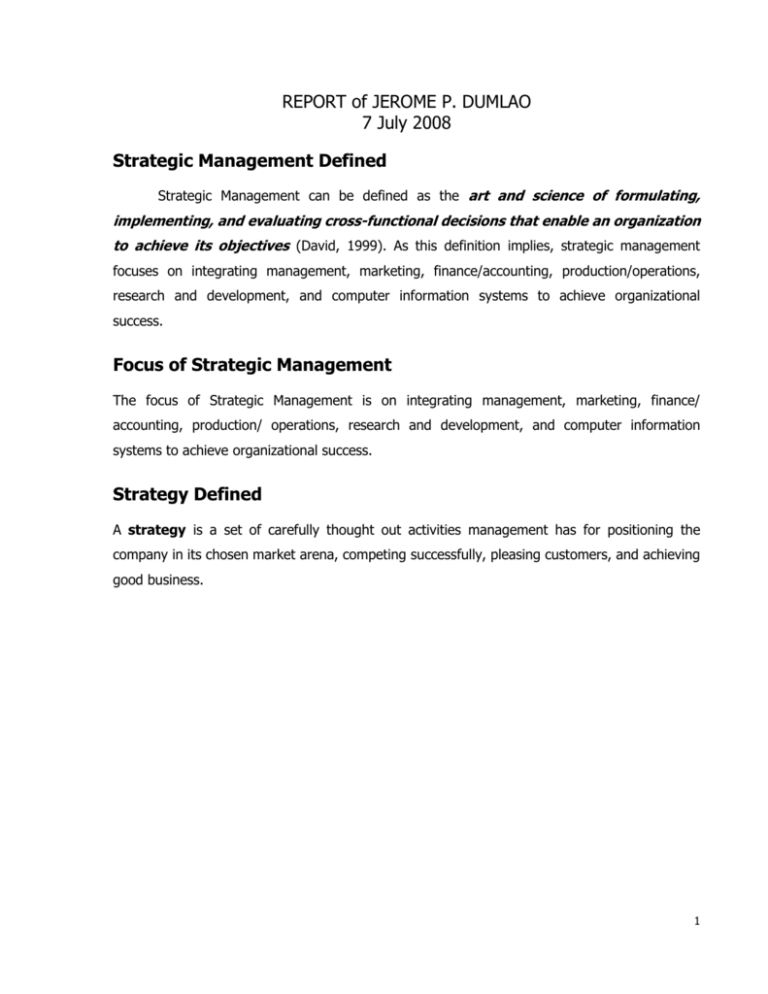
REPORT of JEROME P. DUMLAO 7 July 2008 Strategic Management Defined Strategic Management can be defined as the art and science of formulating, implementing, and evaluating cross-functional decisions that enable an organization to achieve its objectives (David, 1999). As this definition implies, strategic management focuses on integrating management, marketing, finance/accounting, production/operations, research and development, and computer information systems to achieve organizational success. Focus of Strategic Management The focus of Strategic Management is on integrating management, marketing, finance/ accounting, production/ operations, research and development, and computer information systems to achieve organizational success. Strategy Defined A strategy is a set of carefully thought out activities management has for positioning the company in its chosen market arena, competing successfully, pleasing customers, and achieving good business. 1 The Strategy Making Pyramid and Responsibility for Strategic Management A Diversified Company Responsibility of corporate-level managers Corporate Strategy Two-Way Influence Responsibility of business-level general managers Business Strategies Two-Way Influence Responsibility of heads of major functional activities within a business unit or division. Functional Strategies (R&D, manufacturing, marketing, finance, human resources, etc.) Two-Way Influence Responsibility of plant managers, geographic unit managers, and lower-level supervisors Operating Strategies (regions and districts, plants, departments within functional areas) 2 A Single Business Company Responsibility of executive-level managers Business Strategy Two-Way Influence Responsibility of heads of major functional activities within a business Functional Strategies (R&D, manufacturing, marketing, finance, human resources, etc.) Two-Way Influence Responsibility of plant managers, geographic unit managers, and lower-level supervisors Operating Strategies (regions and districts, plants, departments within functional areas) 3 TYPES OF GRAND STRATEGIES INTEGRATION STRATEGIES Forward integration, backward integration, and horizontal integration are sometimes collectively referred to as vertical integration strategies. Vertical integration strategies allow a firm to gain control over distributors, suppliers, and/or competitors. Forward Integration Forward integration involves gaining ownership or increased control over distributors or retailers. Backward Integration Both manufacturers and retailers purchase need materials from suppliers, backward integration is a strategy of seeking ownership or increased control of a firm’s suppliers. This strategy can be especially appropriate when a firm’s current suppliers are unreliable, too costly, or cannot meet the firm’s needs. Horizontal Integration Horizontal integration refers to a strategy of seeking ownership of or increased control over a firm’s competitors. One of the most significant trends in strategic management today is the increased use of horizontal integration as a growth strategy. Mergers, acquisitions, and takeovers among competitors allow for increased economies of scale and enhanced transfer of resources and competencies. INTENSIVE STRATEGIES Market penetration, market development, and product development are sometimes referred to as intensive strategies because they require intensive efforts to improve a firm’s competitive position with existing products. Market Penetration A market penetration strategy seeks to increase market share for present products or services in present markets through greater marketing efforts. This strategy is widely used alone and in combination with other strategies. Market penetration includes increasing the number of salespersons, increasing advertising expenditures, offering extensive sales promotion items, or increasing publicity efforts. Market Development Market development involves introducing present products or services into new geographic areas. 4 Product Development Product development is a strategy that seeks increased sales by improving or modifying present products or services. Product development usually entails large research and development expenditures. DIVERSIFICATION STRATEGIES There are three general types of diversification strategies: concentric, horizontal, and conglomerate. Overall, diversification strategies are becoming less popular as organizations are finding it more difficult to manage diverse business activities. In the 1960s and 1970s, the trend was to diversify so as not to be dependent on any single industry, but the 1980s saw a general reversal of that thinking. Diversification is now on the retreat. Concentric Diversification Adding new, but related, products or services is widely called concentric diversification. Horizontal Diversification Adding new, unrelated products or services for present customers is called horizontal diversification. Conglomerate Diversification Adding new, unrelated products or services is called conglomerate diversification. DEFENSIVE STRATEGIES In addition to integrative, intensive, and diversification strategies, organizations also could pursue joint venture, retrenchment, divestiture or liquidation. Joint Venture Joint venture is a popular strategy that occurs when two or more companies form a temporary partnership or consortium for the purpose of capitalizing on some opportunity. This strategy can be considered defensive only because the firm is not undertaking the project alone. Often, the two or more sponsoring firms form a separate organization and have shared equity ownership in the new entity. Retrenchment Retrenchment occurs when an organization regroups through cost and asset reduction to reverse declining sales and profits. Sometimes called a turn-around or reorganizational strategy, retrenchment is designed to fortify an organization’s basic distinctive competence. During retrenchment, strategists work with limited resources and face pressure from shareholders, employees, and the media. Retrenchment can entail selling off land and buildings to raise 5 needed cash, reduce product lines, closing marginal businesses, closing obsolete factories, automating processes, reducing the number of employees, and instituting expense control systems. Divestiture Selling a division or part of an organization is called divestiture. Divestiture often is used to raise capital for further strategic acquisitions or investments. Divestiture can be part of an overall retrenchment strategy to rid an organization of businesses that are unprofitable, that require too much capital, or that do not fit well with the firm’s other activities. Liquidation Selling all of a company’s assets, in parts, for their tangible worth is called liquidation. Liquidation is recognition of defeat and consequently can be an emotionally difficult strategy. However, it may be better to cease operating than to continue losing large sums of money. Combination Many, if not most, organizations pursue a combination of two or more strategies simultaneously, but a combination strategy can be exceptionally risky if carried too far. No organization can afford to pursue all the strategies that might benefit the firm. Difficult decision must be made. Priorities must be established. Organizations, like individuals, have limited resources. Both organizations and individuals must choose among alternative strategies and avoid excessive indebtedness. Organizations cannot do too many things well because resources and talents get spread thin and competitors gain advantage. In large diversified companies, a combination strategy is commonly employed when different divisions pursue different strategies. Also, organizations struggling to survive may employ a combination of several defensive strategies, such as divestiture, liquidation, and retrenchment, simultaneously. ACQUISITIONS, MERGERS AND LEVERAGED BUYOUTS Acquisition and Merger are two commonly used ways to pursue strategies. An acquisition occurs when a large organization purchases (acquires) a smaller firm, or vice versa. A merger occurs when two organizations of about equal size unite to form one enterprise. When an acquisition or merger is not desired by both parties, it can be called a takeover or hostile takeover. There are many reasons for mergers and acquisitions, including the following: To provide improved capacity utilization To make better use of existing sales force To reduce managerial staff To gain economies of scale To smooth out seasonal trends in sales To gain access to new suppliers, distributors, customers, products, and creditors To gain new technology To reduce tax obligations 6 Leveraged Buyouts A leveraged buyout (LBO) occurs when a corporation’s shareholders are bought out (hence buyout) by the company’s management and other private investors using borrowed funds (hence leveraged). Besides trying to avoid a hostile takeover, other reasons for initiating an LBO are senior management decisions that particular divisions do not fit into an overall corporate strategy or must be sold to raise cash, or receipt of an attractive offering price. The Grand Strategy Matrix The Grand Strategy Matrix has become a popular tool for formulating alternative strategies. All organizations can be positioned in one of the Grand Strategy Matrix’s four strategy Quadrants. A firm’s divisions likewise could be positioned. As illustrated in the figure below, the Grand Strategy Matrix is based on two evaluative dimensions: competitive position and market growth. Appropriate strategies for an organization to consider are listed in sequential order of attractiveness in each quadrant of the matrix. Firm’s located in Quadrant I of the Grand Strategy Matrix are in an excellent strategic position. For these firms, continued concentration on current markets (market penetration and market development) and products (product development) are appropriate strategies. It is unwise for Quadrant I firms to shift notably from its established competitive advantages. When a Quadrant I organization has excessive resources, the backward, forward, or horizontal integration may be effective strategies. When a Quadrant I firm is too heavily committed to a single product, then concentric diversification may reduce the risks associated with a narrow product line. Quadrant I firms can afford to take advantage of external opportunities in many areas: they can take risks aggressively when necessary. 7 THE GRAND STRATEGY MATRIX RAPID MARKET GROWTH 1. 2. 3. 4. 5. 6. Quadrant II Market Development Market Penetration Product Development Horizontal Integration Divestiture Liquidation Quadrant I 1. Market Development 2. Market Penetration 3. Product Development 4. Forward Integration 5. Backward Integration 6. Horizontal Integration 7. Concentric Diversification WEAK COMPETITIVE POSITION 1. 2. 3. 4. 5. 6. STRONG COMPETITIVE POSITION Quadrant III Retrenchment Concentric Diversification Horizontal Diversification Conglomerate Diversification Divestiture Liquidation Quadrant IV 1. Concentric Diversification 2. Horizontal Diversification 3. Conglomerate Diversification 4. Joint Ventures SLOW MARKET GROWTH Firms positioned in Quadrant II need to evaluate their present approach to the marketplace seriously. Although their industry is growing, they are unable to compete effectively, and they need to determine why the firm’s current approach is ineffectual and how the company can best change to improve its competitiveness. Because Quadrant II firms are in a rapid-marketgrowth industry, an intensive strategy ( as opposed to integrative or diversification) is usually the first option that should be considered. However, if the fir is lacking a distinctive competence or competitive advantage, then horizontal integration is often a desirable alternative. As a last result, divestiture or liquidation should be considered. Divestiture can provide funds needed to acquire other businesses or buy back shares of stock. Quadrant III organizations compete in slow – growth industries and have weak competitive positions. These firms must make some drastic changes quickly to avoid further demise and possible liquidation. Extensive cost and asset reduction (retrenchment) should be pursued first. An alternative strategy is to shift resources away from the current business into different areas. If all else fails, the final options for Quadrant III businesses are divestiture or liquidation. Finally, Quadrant IV businesses have a strong competitive position but are in a slow growth industry. These firms have the strength to launch diversified programs into more promising growth areas. Quadrant IV firms have characteristically high cash flow levels and limited 8 internal growth needs and often can pursue concentric, horizontal, or conglomerate diversification successfully. Quadrant IV firms also may pursue joint ventures. Guidelines for Situations When Particular Strategies are Most Effective: Forward Integration When an organization’s present distributors are especially expensive, or unreliable, or incapable of meeting the firm’s distribution needs When the availability of quality distributors is so limited as to offer a competitive advantage to those firms that integrate forward When an organization competes in an industry that is growing and is expected to continue to grow markedly; this is a factor because forward integration reduces an organization’s ability to diversify if its basic industry falters When an organization has both the capital and human resources needed to manage the new business of distributing its own products When the advantages of stable production are particularly high; this is a consideration because an organization can increase the predictability of the demand for its output through forward integration When present distributors or retailers have high profit margins; this situation suggests that a company profitability could distribute its own products and price them more competitively by integrating forward Backward Integration When an organization’s present suppliers are especially expensive, or unreliable, or incapable of meeting the firm’s needs for parts, components, assemblies, or raw materials When the number of suppliers is small and the number of competitors is large When an organization competes in an industry that is growing rapidly; this is a factor because integrative – type strategies (forward, backward and horizontal) reduce an organization’s ability to diversify in a declining industry When an organization has both capital and human resources to manage the new business of supplying its own raw materials When the advantages of stable prices are particularly important; this is a factor because an organization can stabilize the cost of its raw materials and the associated price of its product through backward integration When present supplies have high profit margins, which suggests that the business of supplying products or services in the given industry is a worthwhile venture When an organization needs to acquire a needed resource quickly Horizontal Integration When an organization can gain monopolistic characteristics in a particular area or region without being challenged by the federal government for “ tending substantially” to reduce competition When an organization competes in a growing industry When increased economies of scale provide major competitive advantages 9 When an organization has both the capital and human talent needed to successfully manage an expanded organization When competitors are faltering due to a lack of managerial expertise or a need for particular resources that an organization possesses; note that horizontal integration would not be appropriate if competitors are doing poorly because overall industry sales are declining Market Penetration When current markets are not saturated with a particular product or service When the usage rate of present customers could be increased significantly When the market shares of major competitors have been declining while total industry sales have been increasing When the correlation between dollar sales and dollar marketing expenditures historically has been high When increased economies of scale provide major competitive advantages Market Development When new channels of distribution are available that are reliable, inexpensive, and of good quality When an organization is very successful at what it does When new untapped or unsaturated market exist When an organization has the needed capital and human resources to manage expanded operations When an organization has excess production capacity When an organization’s basic industry rapidly is becoming global in scope Product Development When an organization has successfully products that are in the maturity stage of the product lifecycle; the idea here is to attract satisfied customers to try new ( improved) products as a result of their positive experience with the organization’s present products or services When an organization competes in an industry that is characterized by rapid technological developments When major competitors offer better- quality products at comparable prices When an organization competes in a high- growth industry When an organization has especially strong research and development capabilities Concentric Diversification When an organization competes in a no-growth or a slow-growth industry When adding new, but related, products significantly would enhance the sales of current products When new, but related, products could be offered at highly competitive prices When new, but related, products have seasonal sales levels that counterbalance an organization’s existing peaks and valleys 10 When an organization’s products are currently in the decline stage of the product lifecycle When an organization has a strong management team Conglomerate Diversification When an organization’s basic industry is experiencing declining annual sales and profits When an organization has the capital and managerial talent needed to compete successfully in a new industry When an organization has the opportunity to purchase an unrelated business that is an attractive investment opportunity When there exists financial synergy between the acquired and acquiring firms; note that a key difference between concentric and conglomerate diversification is that the former should be based on some commonality in markets, products or technology, whereas the latter should be based more on profit considerations When existing markets for an organization’s present products are saturated When antitrust action could be charged against an organization that historically has concentrated on a single industry Horizontal Diversification When revenues derived from an organization’s current products or services would increase significantly by adding the new, unrelated products When an organization competes in a highly competitive and/or a no-growth industry, as indicated by low industry profit margins and returns When an organization’s present channels of distribution can be used to market the new products to current customers When the new products have countercyclical sales patterns compared to an organization’s present products Joint Venture When a privately owned organization is forming a joint venture with a publicly owned organization; there are some advantages of being privately held, such as close ownership; there are some advantages of being publicly held, such as to access to stock issuances as a source of capital. Sometimes, the unique advantages of being privately and publicly held can be synergistically combined in a joint venture When a domestic organization is forming a joint venture with a foreign company; a joint venture can provide a domestic company with the opportunity for obtaining local management in a foreign country, thereby reducing risks such as expropriation and harassment by host country officials When the distinctive competencies of two or more firms complement each other especially well When some project is potentially very profitable, but requires overwhelming resources and risks; the Alaskan Pipeline is an example When two or more smaller firms have trouble competing with a large firm When there exists a need to introduce a new technology quickly 11 Retrenchment When an organization has a clearly distinctive competence, but has failed to meet its objectives and goals consistently over time When an organization is one of the weaker competitors in a given industry When an organization is plagued by inefficiency, low profitability, poor employee morale, and pressure form stockholders to improve performance When an organization has failed to capitalize on external opportunities, minimize external threats, take advantage of internal strengths, and overcome internal weaknesses overtime; that is, when the organization’s strategic managers have failed (and possibly will be replaced by more competent individuals) When an organization has grown so large so quickly that major internal reorganization is needed Divestiture When an organization has pursued a retrenchment strategy and it failed to accomplish needed improvements When a division needs more resources to be competitive than the company can provide When a division is responsible for an organization’s overall poor performance When a division is a misfit with the rest of an organization; this can result from radically different markets, customers, managers, employees, values or needs When al large amount of cash is needed quickly and cannot be obtained reasonably from other sources When government antitrust actions threatens an organization Liquidation When an organization has pursued both a retrenchment strategy and a divestiture strategy, and neither has been successful When an organization’s only alternative is bankruptcy; liquidation represents an orderly planned means of obtaining the greatest possible cash for an organization’s assets. A company can legally declare bankruptcy first and then liquidate various divisions to raise needed capital When the stockholders of a firm can minimize their losses by selling the organization’s assets 12 MICHAEL PORTER’S GENERIC STRATEGIES According to Harvard University Professor Michael Porter, strategies allow organizations to gain competitive advantage from three different bases: cost leadership, differentiation, and focus. Porter calls these bases generic strategies. Cost leadership emphasizes producing standardized products at very low per-unit cost for consumers who are price-sensitive. Differentiation is a strategy aimed at producing products and services considered unique industry-wide and directed at consumers who are relatively price-insensitive. Focus means producing products and services that fulfill the needs of small group consumers. Porter’s strategies imply different organizational arrangements, control procedures, and incentive systems. Larger firms with greater access to resources typically compete on a cost leadership and/or differentiation basis, whereas smaller firms often compete on a focus basis. Porter stresses the need for strategists to perform cost-benefit analyses to evaluate “sharing opportunities” among a firm’s existing and potential business units. Sharing activities and resources enhances competitive advantage by lowering costs or raising differentiation. In addition to prompting sharing, Porter stresses the need for firms to “transfer” skills and expertise among autonomous business units effectively in order to gain competitive advantage. Depending upon factors such as type of industry, size of firm, and nature of competition, various strategies could yield advantages in cost leadership, differentiation, and focus. Cost Leadership Strategies A primary reason for pursuing forward, backward, and horizontal integration strategies is to gain cost leadership benefits. But cost leadership generally must be pursued in conjunction with differentiation. A number of cost elements affect the relative attractiveness of generic strategies, including economies or diseconomies of scale achieved, learning and experience curve effects, the percentage of capacity utilization achieved, and linkages with suppliers and distributors. Striving to be the low-cost producer in an industry can be especially effective when the market is composed of many price-sensitive buyers, when there are few ways to achieve product differentiation, when buyers do not care much about differences from brand to brand, or when there are a large number of buyers with significant bargaining power. The basic idea is to underprice competitors and thereby gain market share and sales, driving some competitors out of the market entirely. A successful cost leadership strategy usually passes through the entire firm, as evidenced by high efficiency, low overhead, limited perks, intolerance of waste, intensive screening of budget requests, wide span of control, rewards linked to cost containment, and broad employee participation in cost control efforts. Some risks of pursuing cost leadership are that competitors may imitate the strategy, thus driving overall industry profits down; technological breakthroughs in the industry may make the strategy ineffective; or buyer interest may swing to other differentiation features besides price. 13 Differentiation Strategies Different strategies offer different degrees of differentiation. Differentiation does not guarantee competitive advantage, especially if standard products sufficiently meet customer needs or if rapid imitation by competitors is possible. Successful differentiation can mean greater product flexibility, greater compatibility, lower costs, improved service, less maintenance, greater convenience, or more features. Product development is an example of a strategy that offers the advantages of differentiation. A differentiation strategy should be pursued only after careful study of buyers’ needs and preferences to determine the feasibility of incorporating one of more differentiating features into a unique product that features the desired attributes. A successful differentiation strategy allows a firm to charge a higher price for its product and to gain customer loyalty because consumers may become strongly attached to the differentiation features. Special features to differentiate one’s product can include superior service, spare parts availability, engineering design, product performance, useful life, or ease of use. A risk of pursuing a differentiation strategy is that the unique product may not be valued highly enough by customers to justify the higher rice. When this happens, a cost leadership strategy easily will defeat a differentiation strategy. Another risk of pursuing a differentiation strategy is that competitors may develop ways to copy the differentiating features quickly. Firms thus must find durable sources of uniqueness that cannot be imitated quickly or cheaply by rival firms. Focus Strategies A successful focus strategy depends upon an industry segment that is of sufficient size, has good growth potential, and is not crucial to the success of other major competitors. Strategies such as market penetration and market development offer substantial focusing advantages. Medium and large firms effectively can pursue focus-based strategies only in conjunction with differentiation or cost leadership-based strategies. All firms in essence follow a differentiated strategy. Because only one firm can differentiate itself with the lowest cost, the remaining firms in the industry must find other ways to differentiate their products. Focus strategies are most effective when consumers have distinctive preferences of requirements and when rival firms are not attempting to specialize in the same target segment. Risks of pursuing a focus strategy include the possibility that numerous competitors recognize the successful focus strategy and copy the strategy, or that consumer preferences drift toward the product attributes desired by the market as a whole. AN organization using a focus strategy may concentrate on a particular group of customers, geographic markets, or product line segments in order to serve a well-defined but narrow market better than competitors who serve a broader market. 14 Value Disciplines model The Value disciplines model of Michael Treacy and Fred Wiersema describes three generic value disciplines. Any company must choose one of these value disciplines and act upon it consistently and vigorously. operational excellence: superb operations and execution often by providing a reasonable quality at a very low price. The focus is on efficiency, streamlining operations, Supply Chain Management, no-frills, volume counts. Most large international corporations are working out of this discipline. product leadership: very strong in innovation and brand marketing, operating in dynamic markets. The focus is on development, innovation, design, time-to-market, high margins in a short timeframe. customer intimacy: excel in customer attention and customer service. Tailor their products and services to individual or almost individual customers. Focus is on CRM, deliver products and services on time and above customer expectations, lifetime value concepts, reliability, being close to the customer. Treacy and Wiersema argue in their excellent book The Discipline of Market Leaders that any company must choose to excel in one value discipline, where it aims to be the best - in the world preferably. This does not mean the other 2 dimensions should be completely neglected, but rather that the company should aim to be merely 'OK' in these other two disciplines. The Value Disciplines model is quite similar to the 3 generic strategies from Porter (Cost Leadership, Differentiation, Focus). However there is at least one major difference: according to the Value Disciplines model no discipline may be neglected: threshold levels on the 2 disciplines that are not selected must be maintained. According to Porter, companies that act like this run a risk to get "stuck in the middle". 15
